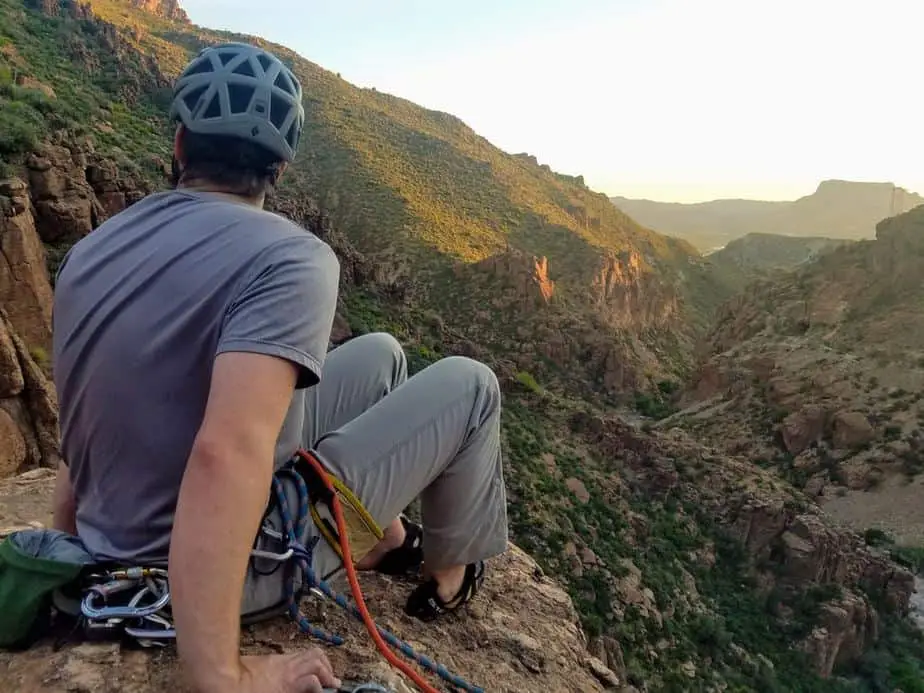Since its inception in the early 1990’s, Petzl’s GRIGRI has made a lot of friends, and a lot of enemies. It seems like everyone you talk to either absolutely loves the device and will never belay with anything else ever again, or else despises it and can’t believe that anyone would consider using it. A lot of the strong feelings about the device are based on anecdotal evidence, and a lot of the hate is because of the nuances of lead climbing belaying.
A GRIGRI is a great choice for belaying a lead climber, but the technique is slightly more complicated than belaying with a more traditional tubular-style device like an ATC. In order to pay out slack, you need to override the cam while still holding onto the brake strand.
All belay devices are not created equal, so you need to learn the intricacies of the device or devices that you use before taking them out onto the rock (or plastic, if that’s your thing). The advice below is specific to Petzl’s GRIGRI, but is very similar to other Assisted-Braking devices like Beal’s Birdie and MadRock’s Lifeguard.
Lead Climbing With a GRIGRI
I think it’s helpful to start by reviewing what a GRIGRI is, and what it is not. Lots of people refer to a GRIGRI as an “auto-locking” belay device, and even treat it so.
The only “auto-locking” equipment available are a few types of carabiners. The GRIGRI, and other devices in its class, is an Assisted-Braking Device. It is designed to supplement a belayer’s ability and attention-not to replace it.
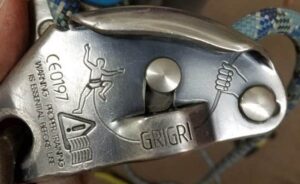
Are GRIGRI’s Safe?
Those in the never-GRIGRI camp are there for a few reasons. Some have seen accidents happen when a belayer accidentally overrides the cam and sends the climber hurdling to the ground. Others tell stories of times when the GRIGRI’s cam just didn’t engage (what belayer is going to admit they panicked and grabbed the cam?).
If you walk around a climbing gym or a popular crag, you are pretty much guaranteed to see belayers making all kinds of mistakes- with a GRIGRI as well as with any other device.
It may seem funny to say, but as climbers we are generally a very cautious bunch. Anchors always have to be (at least) doubled up. Carabiners have to be able to handle forces that are impossible for a human to generate.
What Belay Devices do Climbing Gyms Use?
Climbing gyms are pretty expensive, and a lot of the reason for this is the insurance that they carry. Sure, you waive a lot of your rights with the waivers you sign before climbing, but the gym doesn’t want to get involved in any litigation.
There has been a somewhat recent shift at climbing gyms around the world where they have started to transition over from letting climbers use whatever device they want to making them use gym-provided GRIGRI’s.
Gyms do this for a few different reasons, but the main one is for safety. With all climbers using the same device, it’s easy for their rovers to spot any different techniques.
Everyone receives the same training and the same test, so the gym can ensure that everyone knows what they’re doing (at least to a level of competency). This certainly lowers their risk levels and probably their insurance!
Gyms either do it for increased safety, or there’s a big lobby effort by Petzl to get young climbers hooked on their products. It should be noted that many gyms still allow lead climbers to use whatever device they want.
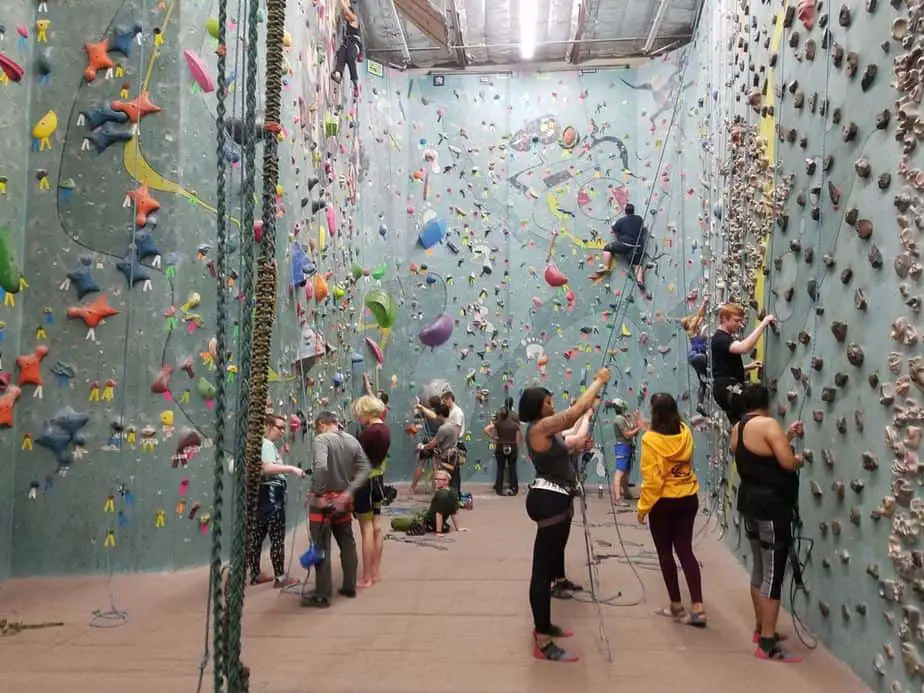
Why Doesn’t Everyone Use a GRIGRI to Belay?
You’re probably thinking, if a GRIGRI-style device is really so much better than an ATC, why do ATC’s still exist? My answer, tongue in cheek, is why anyone drives a car that isn’t a Tesla? Zero emissions, auto-pilot features, and a powerful engine along with all the other tech bells and whistles available…
Now I don’t mean to compare the GRIGRI to a Tesla (I mean come on), but want to point out that personal preference is a big factor in these decisions- along with price (GRIGRI’s are 4-5X the price of an ATC) and familiarity (my grand-daddy belayed with a sticht plate…).
Another thing about climbers is that we have to place a lot of trust in ourselves, in our capabilities and in our belayer. We don’t really like having to trust something else to do the catching for us.
GRIGRI’s also do have their limitations. They only work with certain rope diameters (the cam won’t engage on really thin ropes). Sometimes really light climbers like kids don’t weigh enough to engage the cam.
A slow fall with lots of rope drag or just leaning back in the harness to rest also may not engage the cam. A lot of it does just come down to personal preference.
A lot of GRIGRI-related accidents happen when the climber is being lowered to the ground. Just like with leading, the technique is slightly different than other ‘regular’ devices.
It can be done safely, but needs to be done right. The GRIGRI+ even has a safety override feature that is designed to stop the rope if it is paying out slack too fast even with the handle open.

How is Lead Belaying with a GRIGRI Different?
GRIGRI’s are excellent for top rope climbing, but they are a little bit hard to get used to with lead climbing. The reason is that it is difficult to feed slack quickly to a climber.
With a tubular style device, you adjust the friction level with the angle of your brake hand. Pull it behind your back to completely stop the rope, and move it forward to let it slide.
To feed slack to a climber, you pull the rope through with your upper hand while pushing the rope through in your brake hand. Whether you are slowly letting the rope out as the climber works up between bolts, or quickly letting a few feet out so they can reach up and clip, the technique is the same.
If you use this same technique with a GRIGRI, the act of pulling up on the rope with your upper hand engages the cam and stops the rope from moving. There’s nothing worse as a lead climber than trying to stand up and pull against a stuck rope! It can be really frustrating, and can mean the difference between sending and falling in a tight spot.
Your choices are to either make an extra effort to push the rope through with the brake hand instead of pulling it with the upper hand (which works okay at slow speeds, but not when you need to pay out slack quickly), or to manually override the safety cam by pressing it down with your thumb.
It can be dangerous to override the cam, but if you do it right (the way Petzl recommends) then it can work really well. Here are some tips for giving slack with a GRIGRI-
Tips for Quickly Giving Slack With a GRIGRI
- Step Towards the Wall
The quickest way to give the climber a few feet of slack is usually to step towards the wall. Belayers don’t hang out directly beneath the climber because of the risk of rockfall or dropped gear. It also saves your neck to not have to look completely vertical.
On a vertical climb, this can mean standing 5-10 feet back from the wall. When the climber is about to clip a bolt or place pro, the belayer can quickly give a few feet of slack by stepping forwards towards the wall.
2. Never Let Go of the Brake Strand
This advice is the exact same for every single belay device out there. Your brake hand should NEVER let go of the rope. Just because you sometimes refer to the GRIGRI as an auto-locking device doesn’t make it one. This is probably the number one thing that I see people do wrong- they engage the cam and then take their hands off.
As mentioned above, there are a few reasons not to just blindly trust the cam. A thin rope, a light climber, and extra friction from the rock can keep the cam from engaging without the counter pressure on your brake hand. The GRIGRI is meant as an assist and a backup for the belayer, not to replace the belayer.
3. Use Petzl’s Belay Method
Petzl says it’s okay, and even recommends overriding the cam in order to feed slack out quickly- as long as you do it right. I see people do this lots of different ways. Some people let go of the rope and grab the device in their right hand, pressing the cam with their thumb and pulling up on the rope with their left hand.
Some people grab the device with their left hand and pull the rope out with their right hand. In both of these methods, you have no control of the brake strand.
A third bad example that is probably the most prevalent way of doing it is to keep the brake strand in your right hand, but reach your fingers underneath the device holding it in the palm of your hand. If the belayer trips or falls over for whatever reason, or gets yanked off their feet, they’ll likely squeeze the device even tighter.
If you grab the device in your whole hand then you have the grip strength necessary to override the cam if you grab it as you fall.
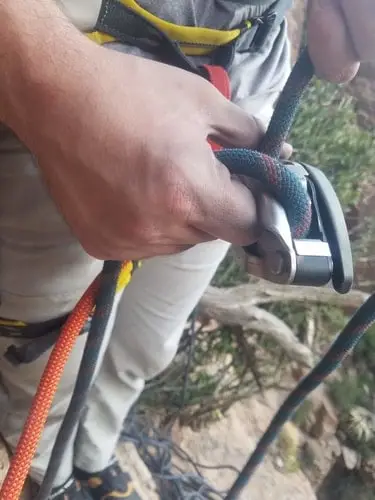
The recommended method is to just grip the GRIGRI with your thumb on the cam, the brake strand in three fingers, and use one finger on the ledge on the side of the GRIGRI. This way your grip strength is limited to your thumb instead of your whole hand.
The problem with this recommended method is that it can be hard to compress the cam once it’s already engaged. This is by design to decrease the likelihood of a belayer panicking and overriding the cam on accident, but is also annoying when you need to get slack out quickly.
You can review more details on Petzl’s recommended belay method on its website .
.
4. Be Patient
The best belay I have ever had came from a GRIGRI aficionado, so it can be done. Focus on making smooth movements instead of jerking the rope around, both when belaying and when leading. Learn how to do it right and the technique will become muscle memory.
Common GRIGRI Belay Errors
Look Ma, No Hands!
Spend 10 minutes at a busy crag or a climbing gym and you’ll see someone taking a ‘belay break.’ We’ve all heard the story of a climber taking a whipper and looking down to see that the belayer is halfway through a sandwich or drink, “Well, the GRIGRI works!”
Yes, the device SHOULD catch you if the belayer is incapacitated or incompetent- but your belayer should also catch you. Redundancy is a nice luxury to have, but keep planning on the belayer. Think about it like a seatbelt- just because you’ve got a seatbelt on doesn’t mean you should drive more recklessly.
Letting Go of the Brake Strand When Feeding Slack
I see a lot of people use the thumb technique on either hand to help feed slack to a climber clipping into a bolt, and letting go of the brake strand. Your brake hand is necessary to help engage the cam and provide a little bit of extra friction.
If all else fails, your hand at least can grab the rope. Climbers are usually most likely to fall right when they’re attempting to clip in, so it’s not a good time to take your hand off of the rope.
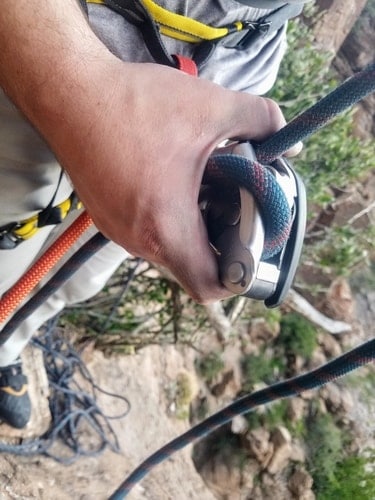
Using the Whole Hand to Depress the Cam
As mentioned above, many climbers will grab the whole device in their brake hand while holding the cam down and letting slack out. If the climber falls while you’re doing this, your hand is probably strong enough to keep it from locking up and stopping them.
Just put one finger under the little curved plate that sticks out and use that instead. That way if you lose your balance or if the climber falls, the cam should still engage.
Panic Lowering
Lowering someone who weighs more than 200lbs can be tricky with a GRIGRI. If you open up the lever all the way then there’s just not a lot of friction and the rope can really get moving. If you don’t open it all the way, then the lower is really really jerky and uncomfortable, and can needlessly wear your rope.
Accidents happen when someone starts to lower a climber and things start to get out of control. Sometimes the belayer freezes, leaving the lever open, and the climber falling. The GRIGRI+ is supposed to correct this with an anti-panic lever, but it too can be overridden by just pulling a little harder.
The best way to add friction is to use the carabiner specifically designed for the GRIGRI, the Freino Locking Carabiner (view on Amazon ). It’s funky looking, but does a unique job.
). It’s funky looking, but does a unique job.
The locking side of the carabiner is for the harness and GRIGRI like a normal locker. The wiregate non-locking side is for you to clip the brake strand of the rope through when lowering someone so that you can easily add a lot more friction. I don’t think it’s necessary for everyone, but can be very useful if this is a problem you run into.
Summary
The Petzl GRIGRI is an excellent device for belaying climbers on top rope, but also can be safely used in lead climbing. There are a few different techniques that should be used, as shown above, in order to belay a leader safely. Learn these techniques, and practice them until you are comfortable before trying them.
Related Questions
Can you Top Belay with a GRIGRI? You can top belay from a belay station one of two ways. One way is to redirect the rope up through the anchor and belay off of your harness as you would normally. You can also connect the GRIGRI directly into the anchor without connecting it to your harness, making sure that the cam is not blocked and the rope flow is correct. Never let go of the brake strand.
Is a GRIGRI worth it? A GRIGRI costs about 5 times as much as a regular tubular device like an ATC, but the added cost is worth it for the peace of mind. A lapse in attention, an aggressive fall, or a falling rock can render a belayer useless while the GRIGRI will always work when used correctly. Consider a cheaper alternative like the Beal Birdie.
See Also:
How Much Weight Can a Quickdraw Hold?

